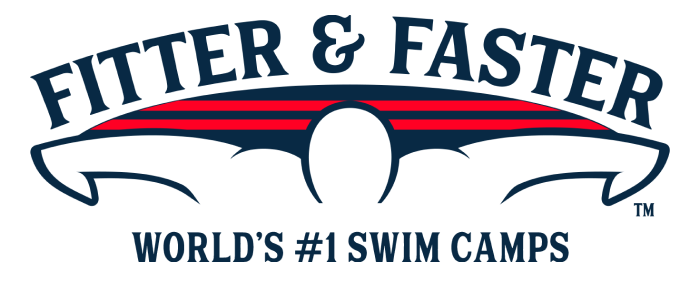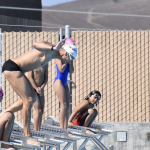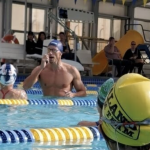Past Clinic: 2022 Nampa, ID Swim Camp
Harward Rec Center aka/ Nampa Rec Center
131 Constitution Way,
Nampa,
ID 83686
A description of what was covered at this past clinic is below the upcoming clinics.
Upcoming Swim Clinics and Camps
Within 250 miles of Nampa, ID.
Past Clinic
Introduction
Fitter & Faster is producing TWO, 2-day swim camps in Nampa, ID on June 24 & 25, 2022! One camp is for swimmers ages 13 and over. The other camp is for ages 12 & under! SAVE when you purchase the "Full Camp Bundle" for your swimmer's age group.
Ages 13 & over: EXPLOSIVE PERFORMANCE: STARTS, TURNS & UNDERWATERS
DAY 1: Explosive Starts & Turns
DAY 2: The Fifth Stroke - Underwaters
Ages 12 & under: BUTTERFLY & BREASTSTROKE TECHNIQUE
DAY 1: High Performance Butterfly Technique
DAY 2: High Performance Breaststroke Technique
Click the “Curriculum Menu” below for details on each camp! Session sizes are limited to only 24 participants to allow for the best learning experience.
Select a curriculum below
Explosive Performance: Starts, Turns, & Underwaters (13 & OVER)
The momentum generated from an explosive start and turns are the FASTEST that elite swimmers are moving in a race! The more efficient, powerful and hydrodynamic your swimmer is, directly impacts their speed and distance they travel in the water before taking their first stroke!
- DAY 1: EXPLOSIVE STARTS & TURNS! (June 24): The better a swimmer’s technique is off the starting block, the more speed they will carry into the water. Day 1 of this swim camp will help your swimmer improve their starts & turns!
- Block Starts: To ensure an explosive start, a swimmer needs to set themselves up properly on the block. The elite clinicians will work with participants on the optimal positioning of your swimmer’s entire body to allow for a quick reaction time and optimal speed.
- Streamline: The streamline - if done properly - will be the fastest a swimmer travels while in the water. Proper streamlines are even faster than underwater dolphin kicking. Even the most elite swimmers in the world are constantly working on improving their streamline. Your swimmer will get tips to improve their streamline and a better appreciation of what they need to do on every single wall in practice and in races.
- Breakouts: Many swimmers add movement within their breakout that creates drag and destroys all of the speed created during their underwaters. Participants will work on timing their breakouts to explode into each lap.
- Momentum: At the elite level of swimming, walls aren’t just used for turning around - they are used to generate speed and momentum going into the next lap. Outside of the elite ranks, most swimmers stop or slow down while going into the wall, which kills their momentum! We will work with participants on the intricacies of approaching every wall at top speed and seamlessly initiating their “turn”.
- Flip Turns: Flip turns are an opportunity for your swimmers to increase momentum in the middle of a race! Flip turns in which the athletes slow down or have “mechanical” movements negatively impact the speed at which a swimmer comes off the wall. We will work with your swimmer to produce fast flip turns so that they can explode off the walls at maximum speed.
- Open Turns: Elite butterflyers and breaststrokers utilize speed from their last lap to create momentum and even more speed at the beginning of the next lap. Their open turns are actually not “turns”, but more like high-speed pivots. Participants in this session will work on these techniques to have much faster open turns!
- Finishes: Setting yourself up for a fast finish is very similar to setting yourself up for a strong turn in any race. Races are won and lost by hundredths-of-a-second at every swim meet. Many races come down to the last few strokes. At this camp, your swimmer will learn techniques to set themselves up for a well-timed finish when they are still about 10 yards from the wall.
- DAY 2: THE FIFTH STROKE - UNDERWATER DOLPHIN KICKING (June 25): Why do elite swimmers have faster times in “short course” pools than in “long course” pools? It’s the power they’re able to generate from the walls, leading into the fastest sequence in every lap of a race: streamline -> underwater dolphin kick -> breakout!
- Streamline: The streamline - if done properly - will be the fastest a swimmer travels while in the water. Proper streamlines are even faster than underwater dolphin kicking. Even the most elite swimmers in the world are constantly working on improving their streamline. Your swimmer will get tips to improve their streamline and a better appreciation of what they need to do on every single wall in practice and in races.
- Initiating Underwater Dolphin Kicking: Elite swimmers want to maximize their streamline on every single lap. So, they don’t want to start their underwater dolphin kicking while they’re still achieving maximum speed in their streamline. They also don’t want to start the underwater dolphin kicking after their streamline has begun to slow. Your swimmer is going to learn how to time when to begin their underwater dolphin kicking.
- Powerful Underwater Dolphin Kicking: There are a few different techniques that swimmers use when underwater dolphin kicking. The common theme of these techniques is that the best swimmers kick up and down with equal power. We will show your swimmer the different techniques that elite swimmers use and teach them how to implement.
- Number Underwater Dolphin Kicking: Figuring out the optimal number of kicks off each wall, for each race, is essential to fast swimming. Elite swimmers want to spend only the absolute necessary amount of time underwater to establish speed with each length. They want to avoid losing their breath and taking weak kicks.
Butterfly and Breaststroke Technique Camp (12 & UNDER)
Butterfly and breaststroke utilize similar body position, “undulating” movements, and an early “catch” to get across the pool with efficiency and speed. They are called the “short axis” strokes because swimmers do not rotate their body at the spine, as is done in freestyle and backstroke. Rather in butterfly and breaststroke, swimmers bend at the hips to generate power and forward momentum. Over two days, your swimmer, no matter their level, will improve their butterfly and breaststroke technique, racing and training skills!
- DAY 1: HIGH PERFORMANCE BUTTERFLY TECHNIQUE (June 24): At the highest level of swimming, butterfly is the second fastest stroke and beautiful to watch because of its rhythmic and powerful strokes. There are some complexities to establishing a smooth, rhythmic fly, but with practice and attention to detail your swimmer can master the stroke and begin swimming it for longer distances and at very fast speeds!
- Bodyline: A butterfly race is going to be fastest with a proper bodyline. Even the slightest adjustment of the chin, neck, and/or back can make a huge difference. As swimmers mature in the sport and grow physically, their body position shifts and bad habits can emerge. Participants will learn and practice proper posture and engagement of their core to have a strong foundation for better technique - creating a full-body connection for more hydrodynamic and efficient butterfly strokes.
- Kick: Each butterfly stroke has two kicks to propel the swimmer towards the other end of the pool! If the kicks are properly timed and equally strong, they can positively impact your swimmer’s efficiency and stroke timing! Your swimmer will work on how and when to kick in butterfly for maximum speed.
- Pull: Long and smooth strokes allow swimmers to have a more efficient and fluid butterfly. The pull in butterfly keeps a swimmer accelerating forward. Your clinicians will work with participants to establish an early vertical forearm, “the catch”, enabling the swimmers to put immediate pressure back on the water. Properly completing the stroke keeps the swimmer moving forward efficiently and fast.
- Timing: The timing of the breath in butterfly has a direct relationship on a swimmer’s body position, pull, kick and TIMES! At this camp, we will work with participants on breathing with their chin low to the water... and WHEN to breathe in their stroke cycle so that they develop the most efficient stroke possible!
- DAY 2: HIGH PERFORMANCE BREASTSTROKE TECHNIQUE (June 25): At the highest level of swimming, breaststroke has the most varied technique. Out of the eight finalists at the Olympic Games, you might see eight different styles of breaststroke! A swimmer's timing and ability to eliminate resistance are hallmarks of an efficient and powerful breaststroker. No matter your swimmer’s level, this session will strengthen their technique and lead to faster and more efficient breaststroke races… and faster IM’s!
- Bodyline: A breaststroke race is going to be fastest with a proper bodyline. Even the slightest adjustment of the chin, neck, and/or back can make a huge difference. Elite breaststrokers focus on minimizing drag by “catching water” on their hands and feet as quickly as possible, so they can shoot back into a “straight bodyline” where they can glide at top speed.
- Kick: The kick creates a lot of the power in breaststroke. Swimmers need to keep their knees high in the water and snap their feet quickly around and back to create a powerful kick. Our clinicians will work with participants to strengthen their kick for the ultimate propulsion forward!
- Pull: The name of the game in breaststroke is to create as much propulsion as possible in the pull while minimizing resistance… and then quickly getting back into a straight bodyline to establish a high speed glide. Participants at this session will focus on setting up a proper "catch" and keeping their hands and elbows high on the water throughout the entire pull. The techniques your swimmer will practice will minimize resistance and enable them to maintain forward momentum for the fastest breaststroke.
- Timing: Fast, flowing breaststroke is the result of proper timing between a swimmer’s hands and feet. Establishing proper timing in your swimmer’s breaststroke will allow for more fluidity, power and speed. Participants in this session will learn how elite swimmers time their breaststroke for ultimate efficiency and the fastest races.
SESSION START TIMES: Ages 13 & Over:
- Friday, June 24: Check in 6:45 AM, Camp 7-9:30 AM
- Saturday, June 25: Check in 8 AM, Camp 8:15-10:45 AM
- Friday, June 24: Check in 3:45 PM, Camp 4-6 PM
- Saturday, June 25: Check in 11:15 AM, Camp 11:30-1:30 PM

Patrick McCloskey
Patrick McCloskey swam for four years at the University of the Incarnate Word in San Antonio, Texas. Patrick began his swim coaching career with his neighborhood team when he graduated high school, and that’s when he discovered his passion for coaching swimmers. Patrick has coached and worked with numerous NCAA champions and Olympians from the U.S. and abroad. He brings excitement, knowledge, and enthusiasm to every clinic he coaches.
Search all of our clinics...or request a clinic in your area











